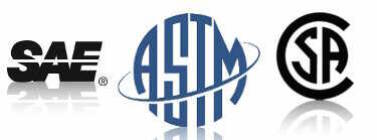What is the maximum service temperature for A193 Grade B7 bolts?
Portland Bolt is often faced with this question, and because there are many conflicting sources online, we decided to do a little research on our own. The resource we found most helpful was ASME B31.1-2012. In this specification, there is a table which shows the maximum allowable stress values in Tension (KSI) for metal temperature. As seen in Table A-10, when the Tension (KSI) value begins to decrease, the integrity of the bolt becomes compromised. This is where the maximum service temperature comes into play. For example, if you take the red group, which covers the allowable stress values applied to bolting materials 2-1/2” in diameter and smaller, the starting Tension value is 25 KSI and keeps this value through 700°F; however, above this temperature, the Tension value begins to decrease. This marks the point at which the bolt is no longer functioning at its highest capacity.
- Red Group: These allowable stress values apply to bolting materials 2-1/2” in diameter and smaller
Maximum Service Temperature: 700°F - Green Group: These allowable stress values apply to bolting materials larger than 2-1/2” in diameter but not larger than 4” in diameter
Maximum Service Temperature: 700°F - Blue Group: These allowable stress values apply to bolting materials larger than 4” in diameter but not larger than 7” in diameter
Maximum Service Temperature: 750°F
Table A-10 Bolts, Nuts, and Studs
| Low and Intermediate Alloy Steel | |||||||||||||||||||||
|---|---|---|---|---|---|---|---|---|---|---|---|---|---|---|---|---|---|---|---|---|---|
| Grade | B5 | B7 | B7 | B7 | B7M | ||||||||||||||||
| Spec. # | A193 | ||||||||||||||||||||
| Maximum Allowable Stress Values in Tension, ksi, for Metal Temperature, °F, Not Exceeding | -20 to 100 | 20.0 | 25.0 | 23.0 | 18.8 | 20.0 | |||||||||||||||
| 200 | 20.0 | 25.0 | 23.0 | 18.8 | 20.0 | ||||||||||||||||
| 300 | 20.0 | 25.0 | 23.0 | 18.8 | 20.0 | ||||||||||||||||
| 350 | - | - | - | - | - | ||||||||||||||||
| 400 | 20.0 | 25.0 | 23.0 | 18.8 | 20.0 | ||||||||||||||||
| 450 | - | - | - | - | - | ||||||||||||||||
| 500 | 20.0 | 25.0 | 23.0 | 18.8 | 20.0 | ||||||||||||||||
| 600 | 20.0 | 25.0 | 23.0 | 18.8 | 20.0 | ||||||||||||||||
| 650 | 20.0 | 25.0 | 23.0 | 18.8 | 20.0 | ||||||||||||||||
| 700 | 20.0 | 25.0 | 23.0 | 18.8 | 20.0 | ||||||||||||||||
| 750 | 20.0 | 23.6 | 22.2 | 18.8 | 20.0 | ||||||||||||||||
| 800 | 18.5 | 21.0 | 20.0 | 18.0 | 18.5 | ||||||||||||||||
| 850 | 14.5 | 16.3 | 16.3 | 16.3 | 16.5 | ||||||||||||||||
| 900 | 10.4 | 12.5 | 12.5 | 12.5 | 12.5 | ||||||||||||||||
| 950 | 7.6 | 8.5 | 8.5 | 8.5 | 8.5 | ||||||||||||||||
| 1000 | 5.6 | 4.5 | 4.5 | 4.5 | 4.5 | ||||||||||||||||
| 1050 | 4.2 | - | - | - | - | ||||||||||||||||
| 1100 | 3.1 | - | - | - | - | ||||||||||||||||
| 1150 | 2.0 | - | - | - | - | ||||||||||||||||
| 1200 | 1.3 | - | - | - | - | ||||||||||||||||
| ASME B31.1 - 2012 | |||||||||||||||||||||
With that being said, Portland Bolt does not have any engineers on staff, so we are not be able to give any information on the bolt’s ability to function at a higher level of heat. The bolt would be compromised, but to what extent, we do not know. That would be a question more suitable for an engineer or metallurgist.
Coatings and Application Limits
When an A193B7 bolt has some form of protective coating, there are limitations to the maximum service temperature the bolts should be exposed to in their respective applications. In the appendixes of the A193 grade, ASTM lays out the limited service temperatures for galvanized and cadmium plated coatings below:
“Use of coated fasteners at temperatures above approximately one-half the melting point (Fahrenheit or Celsius) of the coating is not recommended unless consideration is given to the potential for liquid and solid metal embrittlement, or both. The melting point of elemental zinc is approximately 780°F [415°C]. Therefore, application of zinc-coated fasteners should be limited to temperatures less than 390°F [210°C]. The melting point of cadmium is approximately 600°F [320°C]. Therefore, application of cadmium-coated fasteners should be limited to temperatures less than 300°F [160°C].”
Other Specifications
In regard to other popular specifications and their maximum service temperatures, the table below shows the ratings for bolts made to the A307 and A449 specifications. While the A193 specification covers bolts made from a high strength alloy steel, the A307 specification covers common mild steel bolts, and the A449 specification covers medium carbon or alloy steel bolts that have been quenched and tempered. In regard to these two specifications, ASME B31.1-2012 clearly states, “These materials are not acceptable for construction of pressure-retaining parts of boiler external piping. In regard to ASTM A307, this material shall not be used above 400°F. The allowable stress value is 7,000 psi. In regard to ASTM A449, these allowable stress values are established from a consideration of strength only and will be satisfactory for average service.” As shown in the table below, the ASTM A307 materials are not rated for temperatures above 400°F and the ASTM A449 materials are not rated for temperatures above 600°F.
- Yellow Group: These allowable stress values apply to all parameters of the A307 specification
Maximum Service Temperature: 400°F - Pink Group: These allowable stress values apply to A449 bolting materials less than or equal to 1” in diameter.
Maximum Service Temperature: 600°F - Orange Group: These allowable stress values apply to A449 bolting materials greater than 1” in diameter and less than or equal to 1-1/2” in diameter
Maximum Service Temperature: 600°F - Blue Group: These allowable stress values apply to A449 bolting materials greater than 1-1/2” in diameter and less than or equal to 3” in diameter.
Maximum Service Temperature: 600°F
Table A-10 Bolts, Nuts, and Studs
| Carbon Steel | |||||||||||||||||||||
|---|---|---|---|---|---|---|---|---|---|---|---|---|---|---|---|---|---|---|---|---|---|
| Grade | 1, 2, 2H | B | - | - | - | ||||||||||||||||
| Spec. # | A194 | A307 | A449 | A449 | A449 | ||||||||||||||||
| Maximum Allowable Stress Values in Tension, ksi, for Metal Temperature, °F, Not Exceeding | |||||||||||||||||||||
| -20 to 100 | - | 7.0 | 23.0 | 20.2 | 14.5 | ||||||||||||||||
| 200 | - | 7.0 | 23.0 | 20.2 | 14.5 | ||||||||||||||||
| 300 | - | 7.0 | 23.0 | 20.2 | 14.5 | ||||||||||||||||
| 350 | - | - | - | - | - | ||||||||||||||||
| 400 | - | 7.0 | 23.0 | 20.2 | 14.5 | ||||||||||||||||
| 450 | - | - | - | - | - | ||||||||||||||||
| 500 | - | - | 23.0 | 20.2 | 14.5 | ||||||||||||||||
| 600 | - | - | 23.0 | 20.2 | 14.5 | ||||||||||||||||
| 650 | - | - | - | - | - | ||||||||||||||||
| 700 | - | - | - | - | - | ||||||||||||||||
| 750 | - | - | - | - | - | ||||||||||||||||
| 800 | - | - | - | - | - | ||||||||||||||||
| 850 | - | - | - | - | - | ||||||||||||||||
| 900 | - | - | - | - | - | ||||||||||||||||
| 950 | - | - | - | - | - | ||||||||||||||||
| 1000 | - | - | - | - | - | ||||||||||||||||
| 1050 | - | - | - | - | - | ||||||||||||||||
| 1100 | - | - | - | - | - | ||||||||||||||||
| 1150 | - | - | - | - | - | ||||||||||||||||
| 1200 | - | - | - | - | - | ||||||||||||||||
| ASME B31.1 - 2012 | |||||||||||||||||||||
If you have any questions regarding the service temperature of A193 Grade B7 bolts, or any other fastener related questions, give Portland Bolt a call! Our highly experienced estimators are fastener experts and will be happy to field any technical questions you may have.





Dear sir
Please arrange details High temperature alenkey bolt 300 degrees temperature load 10 mm x 25 mm.
@Haresh- Apologies but we do not know what you are asking.
Hello dane Mc Kinnon
is it the A193 grade B7 limited for low temperatures? I read the ASME A320 and the A193 and seems that between grade B7 from A193 and grade L7 from A320 the only diference is an impact test?
What is the minimun temp. the grade B7 should be used for pressure vessel
best
@David- The ASTM standard itself does not discuss temperature limits, high or low. The main difference between A193 B7 and A320 L7 is the charpy impact test. If you are wanting to use B7 in low temperature environments, you will need to consult the boiler and pressure vessel codes. We are not familiar enough with them to comment.
What is the maximum service temperature for ASTM A325 grade bolts?
Similar response is available for other grade. refer
https://www.portlandbolt.com/technical/faqs/service-temperature-of-a193b7-bolts/
@Nasir- Apologies, but we do not have that information. We have looked, but have never found published information regarding A325 service temperatures.
Hi ,
Can you give me the allowable shear and Tensile stress of A193 B7 bolts for structural engineering purpose.
@Nagaraju- Apologies, but we do not have that information. You will need to consult the ASME codes or some other engineering code. Sorry we cannot help.
Please let us know up to what maximum temperature use of B7 bolt is suitable.
@Subrata- ASTM does not define a maximum temperature for A193 B7 materials. The maximum allowable temperature is typically defined by engineering codes specific to your application.
SA193 B7 bolts are they rated for shocks generated by impact wrenches?
@Ali- We are not aware of any shock rating for impact wrenches regardless of grade. Apologies.
ASME B31.1 Table A-10 Note (1) gives the service temperature limits for A194 too:
Grade 1 and 2: -20 to 600 °F
Grade 2H: -20 to 800 °F
etc.
Regards
I believe you have mislabeled the chart above. The stresses are not the maximum allowable, but design stresses for the ASME pressure vessel code calculation. The maximum allowable bolt stress for a B7 (Dia.<2.5)is 70% of yield per ASME PCC-1.
@Jayson – I double checked Table A-10 from ASME B31.1-2012, which is what we used when writing this FAQ and it clearly says these values are the “Maximum Allowable Stress Values”.